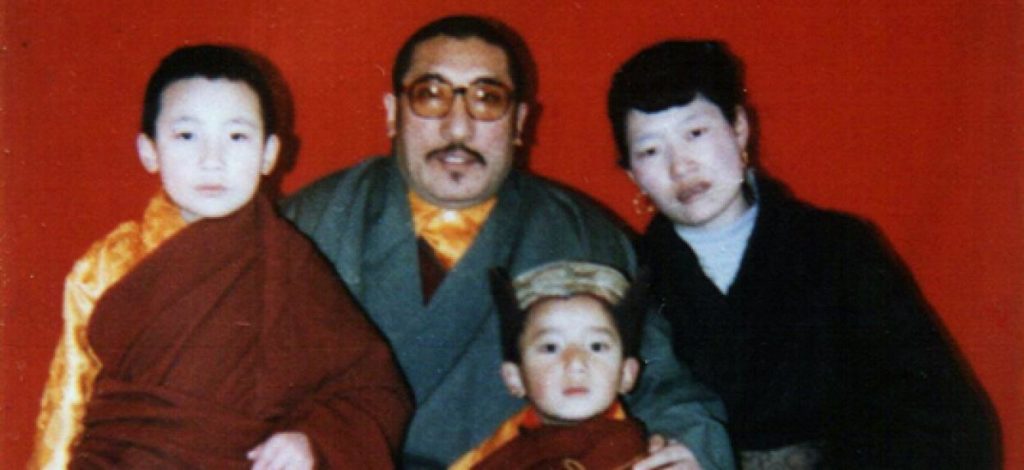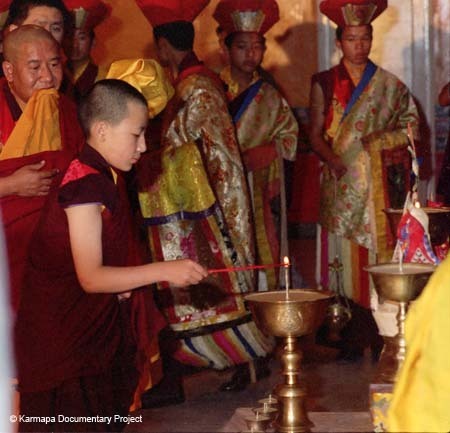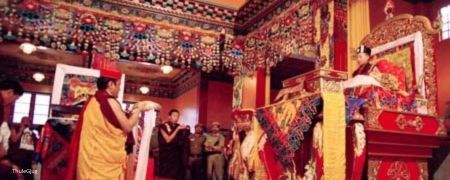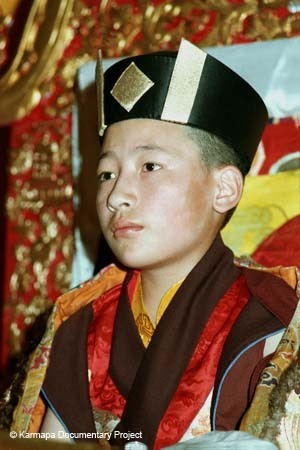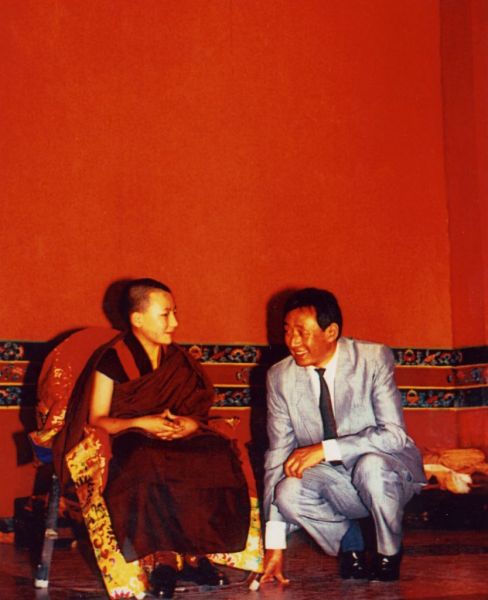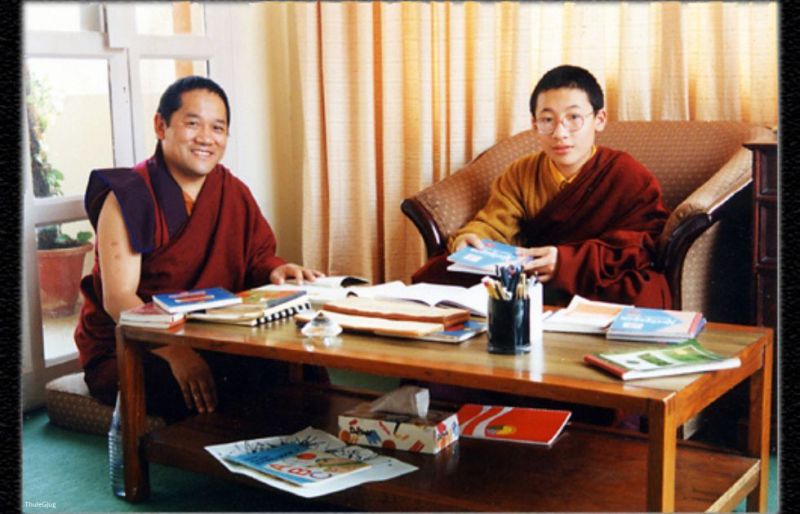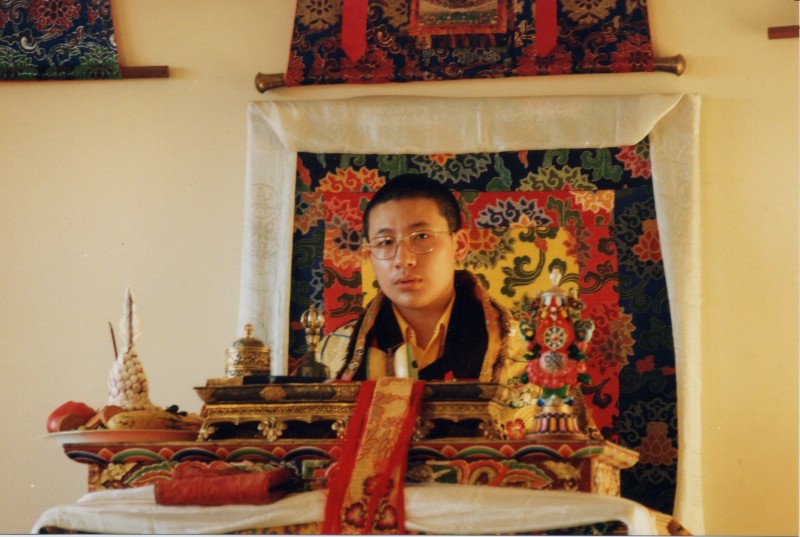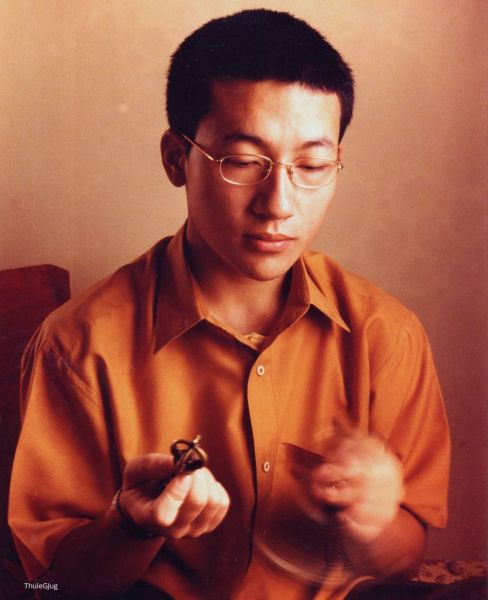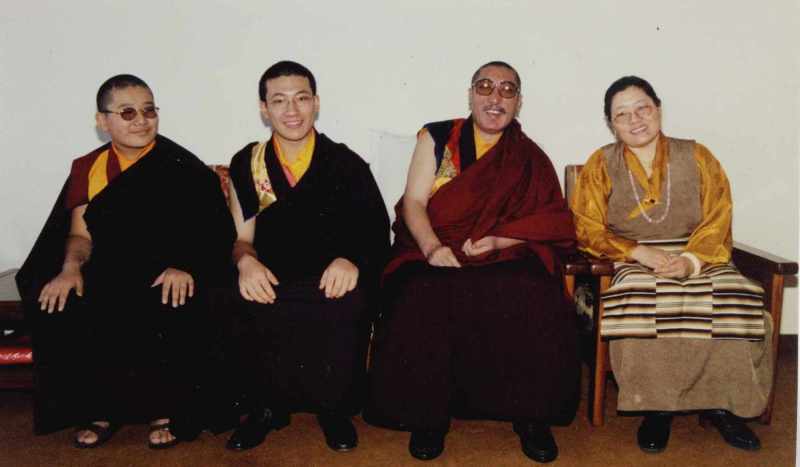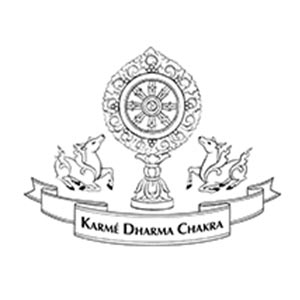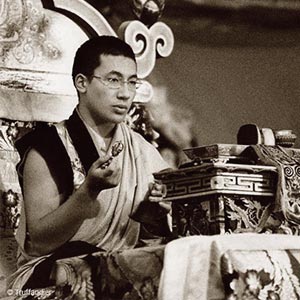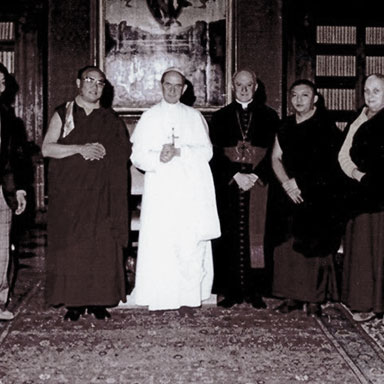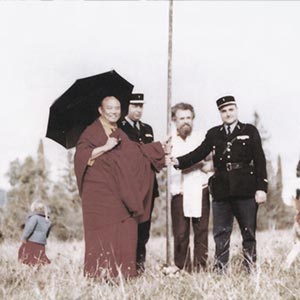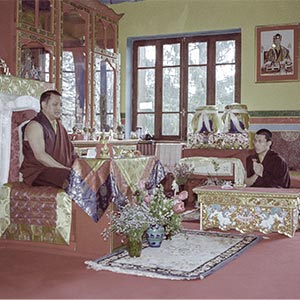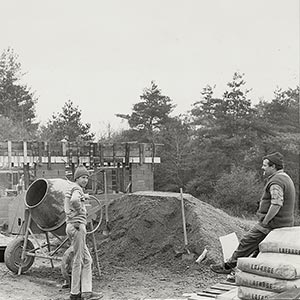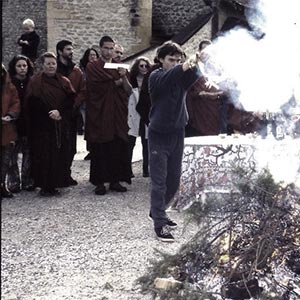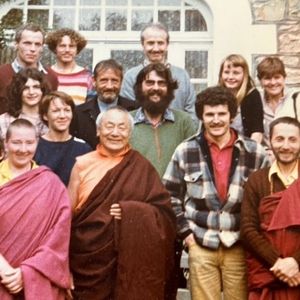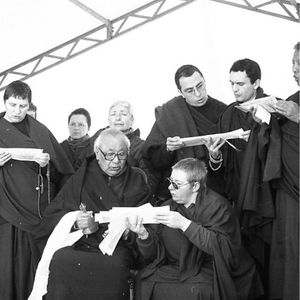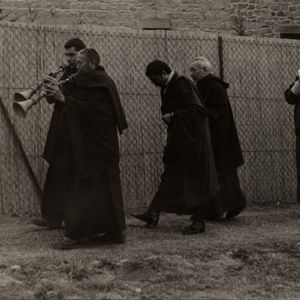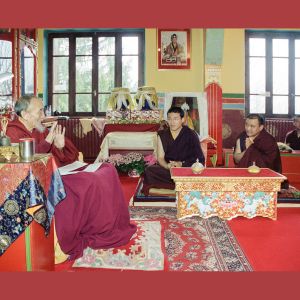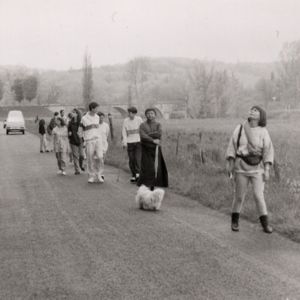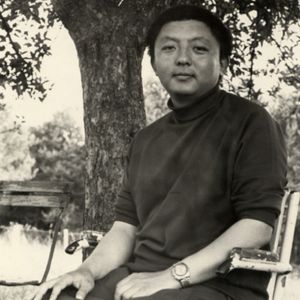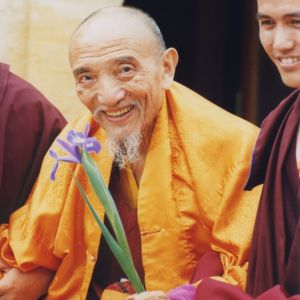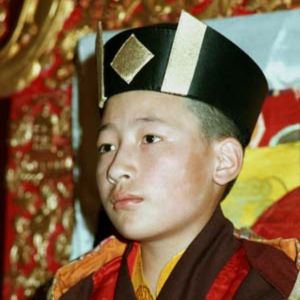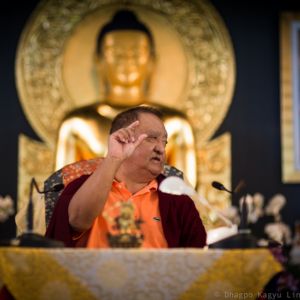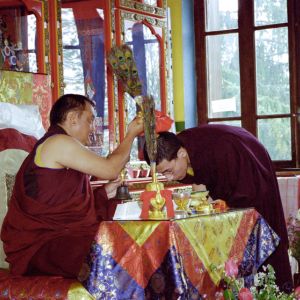Eighteen months after the passing of His Holiness the 16th Gyalwa Karmapa Rangjung Rigpe Dorje on November 5, 1981, his reincarnation, later recognized by the 14th Künzig Shamarpa, was born in the Barkor area of Lhasa on May 6, 1983.
His father, the 3rd Mipham Rinpoche, an emanation of Manjushri, is the reincarnation of the 1st Mipham Rinpoche, the renowned Nyingma master and influential scholar. He spent thirteen years in retreat in Junyung Gompa, his monastery in Tibet where, among many other practices, he accomplished two thousand Nyungne rituals of thousand-armed Chenrezig.
His mother, Dechen Wangmo, from the Kham region, comes from a family of devout Dharma practitioners. When she was four months pregnant and living in Lhasa, her husband Mipham Rinpoche had to leave due to his spiritual responsibilities in Kham.
“He gave me very precise instructions to follow, like being vegetarian, making many wishes and circumambulations and being very careful so that everything goes well for the child and myself,” she recalled in an interview given at Dhago Kundreul Ling in 2004.
When I was pregnant with His Holiness, I dreamt of a very tall man with a long beard. I didn’t know who it was, so I asked Mipham Rinpoche. He said that it was a very favorable sign and that I should continue making wishes. After ten months and ten days, I gave birth to Karmapa at the hospital. The nurse and doctor told me that at the time of birth there was no blood but a white liquid, like water. Mipham Rinpoche had insisted that my father be at my side. He told me that there had been rainbows that day.
Very early on, Karmapa, then known as Tenzin Khyentse, gave hints as to who he was on several occasions. As Dechen Wangmo recounts in the above interview and in the documentary, From Youth to Mastery.[1]
When the Karmapa was not even one year old, we were in Lhasa. One day I was with the sister of the 16th Karmapa, Dorje Kandro. We were chatting over tea, and the Karmapa was in my arms. Upon seeing her the Karmapa beamed all over his face. She asked, ‘Who are you? What’s the matter with you ?’ He raised his hands and said ‘I am the Karmapa.’ We were both very surprised that he could speak, and Dorje Kandro was very touched. She immediately believed it was true—she was sure it was him. The 16th Karmapa had told her that they would certainly meet again. Dorje Kandro made beautiful clothes for His Holiness, very soft, in magnificent fabrics. She was very happy and insisted that I pay close attention to the Karmapa. He was a very good and gentle child. He never got angry. He was always very kind with his parents.
Dechen Wangmo had a second son, Sönam Tsemo Rinpoche, recognized as the eighth reincarnation of the great master and one of the founding fathers of the Sakya tradition, the Ist Sönam Tsemo (1142-1182).
Literally speaking, Karmapa means the one who carries out the activity of all the buddhas in order to help all beings. Lama Jigme Rinpoche explained in the teaching he gave in August 2019:
Karmapa is beyond our ordinary conception. He is not an ordinary individual like you and me. When we practice, the role of the blessing is crucial. It will have an effect on the way we see and understand things. The blessing originates from the quality of ‘great beings.’ When we practice, a contact is established between the quality of these ‘great beings’ and us. This contact is a support for our path. ‘Great beings’ refers to the bodhisattvas such as Gyalwa Karmapa or Chenrezig, meaning beings that are totally free from ignorance and whose only purpose is the benefit of every sentient life, whatever it may be.
This principle of enlightenment and receptacle of a lineage is beyond our ordinary grasping. If his human form might lead one to see him as an individual, Himalayan practitioners know him as “Buddha Karmapa” (Sangye Karmapa). In the 12th century, the first Karmapa, Düsum Khyenpa, a disciple of Gampopa, prior to his death, described the circumstances of his rebirth. The second Karmapa, Karma Pakshi (1204–1283 CE) was recognized as his reincarnation and thus started the first tradition of reincarnated lamas of Tibet. Since then, the Karmapas have manifested themselves in an unbroken continuity of reincarnations up to the present day.
Historically, one of the Shamarpa’s key responsibilities is to preserve the authenticity and purity of the Kagyu lineage, and in this capacity, find the Karmapa’s genuine emanation. In 1996, during a Karma Kagyu gathering at the Karmapa International Buddhist Institute in New Delhi, Mipham Chökyi Lodrö, His Holiness the 14th Künzig Shamarpa explained,
The process of recognizing and identifying an incarnation is a purely spiritual practice. Recognizing incarnations is an enlightened activity.
(Tendrel 41, August 1996)
This process began in 1986, when the Karmapa was only three years old.[2] It involved indications from the Sakya master Chogye Trichen Rinpoche, from an accomplished spiritual disciple who had received a detailed prophecy from the 16th Karmapa about his future incarnation, as well as Shamarpa’s intensive practice at the Jowo Zamling Karpo (Chenrezig statue) in Kathmandu and at the Tara statue in Pharping as well as a contemplative retreat. In the utmost discretion in light of the political situation, he also sent trustworthy teachers such as Lopön Tsechu Rinpoche to Tibet to meet the child. Kunzig Shamarpa himself travelled incognito to Tibet in an attempt to meet the reincarnation but Chinese surveillance forbade him from approaching the young boy or his parents. On January 15, 1994, the 17th Karmapa escaped to India, a date that correlates with a prediction of the 16th Karmapa:
“I will not stay. I will go to faraway places—I am not certain where—
to use the results of karma from the past.
The cuckoo bird comes to Tibet in the springtime.
On a day when a sad melody is sung six times,
This scenario will happen: People who depend on me will think,
‘Where is the man, Rigdrol, now?’
Isn’t it sad for all of you who depend on me?
The one called Rigdrol is famous far and wide.
People will be saying, ‘He is not there, and we are not sure where he is.’
In its heart, the duck relied on the lake
but the shameless lake brought ice, its partner, and became sealed.
In its heart, the white lion trusted the snowy mountain
but the beautiful white snowy mountain invited sunlight as a partner.
Now I won’t say much. It’s just a joke!
But when the two, a joke and a noble meaning, are joined together, then in
the year hosted by the bird at the time of capturing victory,
I have prayed that we’d meet together happily and joyfully.’’
Prophecy of Rangjung Rigpe Dorje, His Holiness the 16th Gyalwa Karmapa, Tsurphu, Tibet, 1944 [3]
His parents and brother fled separately. Two months later, on March 17, Kunzig Shamarpa led a public recognition ceremony of Trinley Thaye Dorje in New Delhi and in 1996, at Bodhgaya, he performed the traditional hair-cutting ceremony for the 17th Karmapa.
As a supreme nirmanakaya, Karmapa is beyond the stage of training, but in order to accomplish the wellbeing of his disciples and all sentient beings, he followed an extensive training in both the sutric and tantric traditions of Buddha Dharma from prominent teachers such as Künzig Shamarpa himself but also Topga Rinpoche, Professor Sempa Dorje and Khenpo Chrodrak Tenphel Rinpoche.
He received the empowerments and transmissions due to his rank so as to continue the uninterrupted transmission of the Karma Kagyu lineage. Shamarpa also took care that he received teachings and transmissions from other Buddhist lineages and great masters such as Chogye Trichen Rinpoche, Luding Khenchen Rinpoche and Pewar Rinpoche. We have recorded some of them in separate stories on this 50th anniversary website. In 2004, having completed his formal education, Shamarpa declared the 17th Karmapa as Vidhyadhara, holder of the Karma Kagyu lineage.
In From Youth to Mastery, the young Karmapa explains:
The function and significance of Karmapa has always been to benefit all sentient beings through teaching, through developing and though spreading the lineage and transmission of Karma Kagyü and it has been done throughout incarnations of Karmapa. […] The moment I was recognized as Karmapa, I was entrusted with the great responsibility not really to help a few individuals but to commit to the welfare of all beings. This is my commitment as the Gyalwa Karmapa.
Karmapa Chenno
We recite the Karmapa Chenno mantra with the aim of freeing ourselves from suffering and attaining Buddhahood for the benefit of all beings. This particular mantra literally means Karmapa knows everything. Karmapa knows the needs of all beings, and when we open up to him, he can fulfill our wishes through the power of his compassion and the strength of his enlightened mind. So when we recite this mantra, we’re actually saying: because you’re the omniscient Buddha and you know that we’re suffering, you’ve come into this world for our benefit and to free us from this suffering.
Khenpo Tsering, Tendrel No. 41
[1] The 17th Gyalwa Karmapa. From Youth to Mastery. A Film about the Great Buddhist Master, directed by Thule G. Jug. The Karmapa Documentary Project. 2015
[2] See Karma Trinlay Rinpoche. Audacity and Tradition: Shamar Rinpoche. Portrait of a Master of Our Time. Rabsel Editions, La Remuée, 2019.
Sylvia Wong. The Karmapa Prophecies. Rabsel Editions, La Remuée, 2016.
[3] Wong, op cit. pp. 81-90
These photos come from our archives or were collected as part of the research for Dhagpo Kagyu Ling’s 50th anniversary. We have not been able to identify all the authors. The use of these photos is solely for informational purposes within the context of Dhagpo Kagyu Ling’s 50th anniversary celebration. Their use is limited to this event and our website and is not for commercial purposes.
Event
The 17th Karmapa’s birthday as well as the transmissions he received from Künzig Shamar Rinpoche at Kundreul Ling will be marked by a day of practice at Dhagpo Kagyu Ling and Dhagpo Kundreul Ling.
![]() Part of this event will take place onsite only; another part will be offered onsite and online.
Part of this event will take place onsite only; another part will be offered onsite and online.
These photos come from our archives or were collected as part of the research for Dhagpo Kagyu Ling’s 50th anniversary. We have not been able to identify all the authors. The use of these photos is solely for informational purposes within the context of Dhagpo Kagyu Ling’s 50th anniversary celebration. Their use is limited to this event and our website and is not for commercial purposes.

